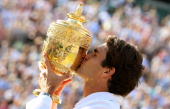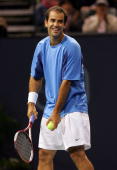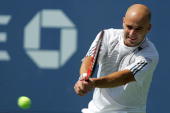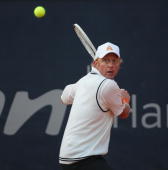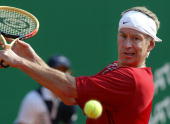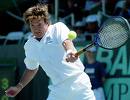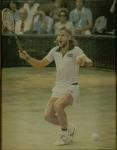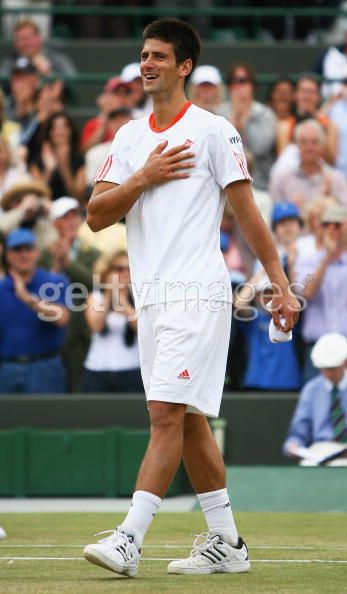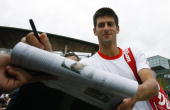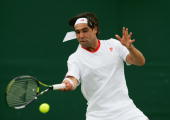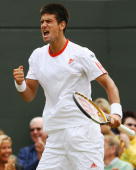Head-to-head: Berdych leads 3-2
2005 Bastad Clay Nadal won 26 62 64
2005 AMS Cincinnati Hard Berdych won 67 62 76
2006 AMS Toronto Hard Berdych won 61 36 62
2006 AMS Madrid Hard Berdych won 63 76
2007 AMS Monte Carlo Clay (O) Nadal won 60 75
Berdych is one of only four active players to have a winning record against Nadal, where there has been more than one career meeting.
This is also a match-up between two players with the best five-set records. Berdych holds the Open Era record for the greatest number of five-set victories with no defeats, with his perfect 9-0 record in five-set matches, while Nadal’s two five-set wins at this tournament advance his record to 9-2.
Nadal came back from two-sets-to-love down to defeat Mikhail Youzhny 46 36 61 62 62 in his second successive five-set victory to advance to his second Wimbledon quarterfinal.
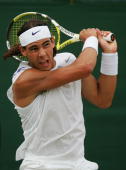
Nadal’s victory over Youzhny followed a 64 64 67 46 75 third round defeat of Robin Soderling in a match that spanned five days due to rain. Earlier, he defeated Mardy Fish 63 76 63 in the first round and Werner Eschauer 62 64 61 in the second.
Nadal is now on a seven match winning streak in five-set matches. His defeat of Youzhny marked the third time in his career that he has won from two-sets-to-love down: at 2005 AMS Madrid, he overcame Ivan Ljubicic 36 26 63 64 76 in the final and at last year’s Wimbledon, he defeated qualifier Robert Kendrick 67 36 76 75 64 in the second round.
Nadal has already appeared in the quarterfinals at all four Grand Slams – 2005-2007 Roland Garros (eventual champion), 2006 Wimbledon (runner-up), 2006 US Open (lost at that stage) and 2007 Australian Open (lost at that stage).
Nadal has a 12-4 record against Czechs, three of those losses being to Berdych.
Nadal reached the 2006 Wimbledon final, losing to Roger Federer 60 76 67 63, marking the first time in the Open Era that the Roland Garros and Wimbledon finals had featured the same two men in the same season, and the first time since 1952 that it had happened.
Nadal was the second Spanish man in history to reach the final here, after Manolo Santana won the title in 1966. He also recorded the best performance by a reigning Roland Garros champion at Wimbledon since Andre Agassi advanced to the final here in 1999.
Having just won Roland Garros for the third time, Nadal now has another chance to become the third man in the Open Era, after Rod Laver and Bjorn Borg, to win both the Roland Garros and Wimbledon titles the same year. Borg achieved the feat for three years in succession 1978-80, while Laver also did it in 1962, one of eight men to achieve this in the pre-Open Era. [For more details, see page 4 of the Preview.]
Nadal’s Roland Garros triumph marked his fifth title this season. He also won at AMS Indian Wells (d. Novak Djokovic 62 75), AMS Monte Carlo (d. Roger Federer 64 64), Barcelona (d. Guillermo Canas 63 64), and AMS Rome (d. Fernando Gonzalez 62 62). He leads the tour for titles won so far in 2007.
Nadal warmed up for Wimbledon by reaching the quarterfinals at Queen’s for the second successive year. He lost in the last eight to eventual runner-up Nicolas Mahut 75 76.
After losing five round of 16 Grand Slam matches, Berdych broke through to his first Grand Slam quarterfinal and is having the best season of his career. He defeated No. 19 seed Jonas Bjorkman 64 60 67 60 in the round of 16, following victories over Nicolas Massu 76 64 62 in the first round, Michael Llodra 76 76 36 76 in the second and Hyung-Taik Lee 64 76 76 in the third.
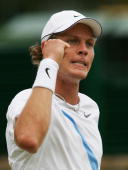
This is Berdych’s fourth straight appearance at Wimbledon. Since his debut in 2004 when he lost in the first round, he has improved on his performance every year. In 2005 he reached the third round, losing to Taylor Dent 63 76 63; and last year as No. 13 seed he won through to the round of 16, losing to Roger Federer 63 63 64.
Mirroring his ever-improving performance at The Championships, Berdych also went one step further than his runner-up finish at 2006 Halle by winning the title at Halle last month. Last year, he lost in the final to Roger Federer 60 67 62, but this year, as No. 4 seed, he defeated Marcos Baghdatis 75 64 in the final to win his first grass court title and first title of 2007. He has now won 18 out of 25 career grass court matches.
For the past five years, the Wimbledon champion has warmed up for The Championships by winning one of the pre-Wimbledon grass court titles. Roger Federer won the title at Halle in 2003-2006 and went on to lift the trophy at Wimbledon, however this year chose not to contest his usual warm-up event. In 2002, Lleyton Hewitt triumphed at Queen’s Club before winning Wimbledon.
Berdych is bidding to become just the third Czech man in the Open Era to reach the Wimbledon semifinals, alongside Jan Kodes (1972-73) and Ivan Lendl (1983-84, 1986-90). There has not been a Czech man in the Wimbledon semifinals since Lendl in 1990. Berdych is bidding to go one step further than Radek Stepanek last year, who lost at the quarterfinal stage to Jonas Bjorkman 76 46 67 76 64.
Berdych broke into the Top 10 for the first time on 23 October 2006 after a successful year. As well as reaching the final at Halle (see above), he was runner-up at Mumbai and a semifinalist at Adelaide, Stuttgart and AMS Madrid. He plays here just outside of the Top 10 at No. 11.
This is Berdych’s highest-ever Grand Slam seeding: his previous best was No. 10 at 2007 Roland Garros.
Against Top 5 opponents, Berdych has a 5-11 record with three of the five victories being over Nadal (see head-to-head above). He made headlines with his first victory over a Top 5 player when, ranked No. 79, he upset No. 1 Roger Federer 46 75 75 in the second round at the 2004 Athens Olympics.
Berdych’s record against Top 5 players is poorer at majors. He has never beaten a Top 5 player at a Grand Slam event, losing all four such matches he has played.
Berdych faces his second lefthander of the tournament today and is on a five-match winning streak against lefthanded players. Overall, he has a 19-5 record against lefthanders, his last loss being to Nadal at AMS Monte Carlo this year.
Berdych is currently on an eight-match winning streak having won the Halle title last month. Prior to Halle, his highlight of 2007 was winning four matches in a row to reach the semifinals at AMS Monte Carlo (l. Rafael Nadal 60 75). He had further clay court success, reaching the semifinals at Munich, quarterfinals at AMS Rome, and also won three matches at the World Team Cup in May to help Czech Republic reach the final.
In Grand Slam play this year, Berdych reached the round of 16 at the Australian Open as No. 13 seed, losing to Nikolay Davydenko 57 64 61 76, but lost in the first round of Roland Garros as No. 10 seed to Guillermo Garcia-Lopez 75 64 64. He has reached the round of 16 at all of the other three majors.
